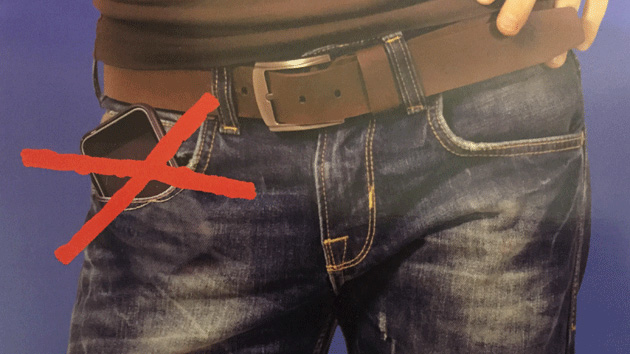Jerry Flynn is retired Captain in the Communications Electronics Engineering Branch from the Canadian Armed Forces. He extensively studied radio communications, including radio and antenna theory, the radio frequency spectrum, radar and telephone systems, electronic warfare, signals intelligence, and more.
Tag: cell phone radiation
Your Cell Phone’s Been Nuking Your Johnson
Smart Meters, Cell Towers, Antennas, and other Multi-Sources of Microwave Radiation
Would you stick your head in a microwave oven?
A math teacher from Ireland tells a story about going to a party where after dinner people are having coffee and tea. Several people have their cell phones on the table. The woman seated beside him places her phone close to his plate. In the video he says why he does not like cell phones, and what happens when he moves her phone away from himself. The table conversation turns ugly.
Dr. Oz: Could your smart phone cause cancer in kids?
Dr. Oz and Dr. Lisa Thornton talk about how wireless devices are affecting kids’ health. Dr. Thornton is a pediatrician and the Medical Director of Pediatric and Adolescent Rehabilitation at the Kids’ Rehab in Chicago. She says our children are in danger. This video is now unavailable.
Berkeley passes cell phone ordinance!
Not on your body, not in your pants!
 The City of Berkeley passed a “right to know” ordinance on Tuesday. Cell phones sold in Berkeley will come with a safety warning:
The City of Berkeley passed a “right to know” ordinance on Tuesday. Cell phones sold in Berkeley will come with a safety warning:
To assure safety, the Federal Government requires that cell phones meet radio frequency (RF) exposure guidelines. If you carry or use your phone in a pants or shirt pocket or tucked into a bra when the phone is ON and connected to a wireless network, you may exceed the federal guidelines for exposure to RF radiation. This potential risk is greater for children. Refer to the instructions in your phone or user manual for information about how to use your phone safely.
Photo credit to Environmental Health Trust. For more info and updates go to: http://bit.ly/berkeleycellordinance
Study links cell phones to addiction
 College students spend an average of 8 hours or more a day on their cellphones and women spend the most time, up to ten hours a day. Excessive use poses potential risks for academic performance, according to a Baylor University study on cellphone activity published in the Journal of Behavioral Addictions.
College students spend an average of 8 hours or more a day on their cellphones and women spend the most time, up to ten hours a day. Excessive use poses potential risks for academic performance, according to a Baylor University study on cellphone activity published in the Journal of Behavioral Addictions.
The study notes that approximately 60 percent of college students admit they may be addicted to their cell phone, and some indicated they get agitated when it is not in sight, said Roberts, lead author of the article “The Invisible Addiction: Cellphone Activities and Addiction among Male and Female College Students.”
“That’s astounding,” said researcher James Roberts, Ph.D., Professor of Marketing in Baylor’s School of Business. “As cellphone functions increase, addictions to this seemingly indispensable piece of technology become an increasingly realistic possibility.”
General findings of the study showed that:
• Of the top activities, respondents overall reported spending the most time texting (an average of 94.6 minutes a day), followed by sending emails (48.5 minutes), checking Facebook (38.6 minutes), surfing the Internet (34.4 minutes) and listening to their iPods. (26.9 minutes).
• Men send about the same number of emails but spend less time on each. “That may suggest that they’re sending shorter, more utilitarian messages than their female counterparts,” Roberts said.
• Women spend more time on their cellphones. While that finding runs somewhat contrary to the traditional view that men are more invested in technology, “women may be more inclined to use cellphones for social reasons such as texting or emails to build relationships and have deeper conversations.”
• The men in the study, while more occupied with using their cellphones for utilitarian or entertainment purposes, “are not immune to the allure of social media,” Roberts said. They spent time visiting such social networking sites as Facebook, Instagram and Twitter. Among reasons they used Twitter were to follow sports figures, catch up on the news — “or, as one male student explained it, ‘waste time,’” Roberts said.
Excessive use of cellphones poses a number of possible risks for students, he said.
“Cellphones may wind up being an escape mechanism from their classrooms. For some, cellphones in class may provide a way to cheat,” Roberts said.
Excessive or obsessive cellphone use also can cause conflict inside and outside the classroom: with professors, employers and families. And “some people use a cellphone to dodge an awkward situation. They may pretend to take a call, send a text or check their phones,” Roberts said.
Roberts noted that the current survey is more extensive than previous research in measuring the number and types of cellphone activities. It also is the first to investigate which activities are associated significantly with cellphone addictions and which are not.
Study participants were asked to respond to 11 statements such as “I get agitated when my cellphone is not in sight” and “I find that I am spending more and more time on my cellphone” to measure the intensity of their addiction.
The study noted that modern cellphone use is a paradox in that it can be “both freeing and enslaving at the same time.”
“We need to identify the activities that push cellphone use from being a helpful tool to one that undermines our well-being and that of others,” Roberts said.
Baylor University did a previous where they reported “Cell phone and instant messaging addictions are driven by materialism and impulsiveness and can be compared to consumption pathologies like compulsive buying and credit card misuse, according to a Baylor University study in the Journal of Behavioral Addictions.”
“Cell phones are a part of our consumer culture,” said study author James Roberts, Ph.D., professor of marketing and the Ben H. Williams Professor of Marketing at Baylor’s Hankamer School of Business. “They are not just a consumer tool, but are used as a status symbol. They’re also eroding our personal relationships.”
CDC recommends caution on cell phones, then removes the warning
In response to questions about cell phone radiation and cancer, the Centers for Disease Control and Prevention (CDC) issued a FAQ about Cell Phones and Your Health,
On August 13, 2014 Dr. Joel Moskowitz reported the CDC called for caution on cell phones stating, “Along with many organizations worldwide, we recommend caution in cell phone use.” (see screen shot of original page)
Dr.Louis Slesin of Microwave News also reported on the recommendation. The statement was a significant step in acknowledging the health threat of wireless radiation from cell and cordless phones, (and by extension other wireless devices such as baby monitors; wi-fi routers; computers; and smart meters.)
A week after Dr. Moskowitz reported on the FAQ, the CDC removed and substantially changed the language.
Can using a cell phone cause cancer?
August 13: There is no scientific evidence that provides a definite answer to that question. Along with many organizations worldwide, we recommend caution in cell phone use. More research is needed before we know for sure if using cell phones causes cancer.
August 20: There is no scientific evidence that provides a definite answer to that question. Some organizations recommend caution in cell phone use. More research is needed before we know if using cell phones causes health effects.
Two other sections were also changed to dumb down the language:
Should people stop using cell phones?
August 13: “Scientific studies are ongoing. Someday cellphones may be found to cause health problems we are not aware of at this time. However it is also important to consider the benefits of cell phones. They can be valuable in an urgent or emergency situation – and even save lives.”
August 20: “At this time we do not have the science to link health problems to cell phone use. Scientific studies are underway to determine whether cell phone use may cause health effects. It is also important to consider the benefits of cell phones. Their use can be valuable in an urgent or emergency situation – and even save lives.”
Do cell phones cause health problems in children?
August 13: “It’s too soon to know for sure. Children who use cell phones – and continue to use them as they get older – are likely to be around RF for many years. If RF does cause health problems, kids who use cell phones may have a higher chance of developing these problems in the future.”
August 20: “It’s not known if cell phone use by children can cause health problems.”
* * * * * * * * * * * *
 I started to wonder if there might be evidence for the recommended caution by the CDC, so I searched their website and found a 2012 Alice Hamilton Award (see Exposure and Risk category/ honorable mention) that went to this study: “Risk of brain tumours in relation to estimated RF dose from mobile phones: results from five Interphone countries”
I started to wonder if there might be evidence for the recommended caution by the CDC, so I searched their website and found a 2012 Alice Hamilton Award (see Exposure and Risk category/ honorable mention) that went to this study: “Risk of brain tumours in relation to estimated RF dose from mobile phones: results from five Interphone countries”
The award description language is strong on the association between cell phone radiation and cancer, especially compared to the CDC FAQ. For example: “…a significant dose-response was found with gliomas for phone use of more than 7 years.”; “…RF emissions from cell phones could be a causal factor in brain cancer.”; “In addition to providing evidence for cell phone carcinogenesis, the findings of these two papers also help identify preventive measures.”
So why did the CDC take back their public health warning? Dr. Moskowitz comments, “Knowing how much administrative oversight CDC typically provides its media relations unit, we doubt that the CDC’s new policy statements were simply a mistake.”
Dr. Louis Slesin writes, “CDC decided it had overstepped —or, more likely, someone held its feet to the fire.”
More on this story at: microwavenews.com See also: Say What CDC Flip Flops on Cell Phone Danger